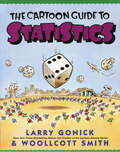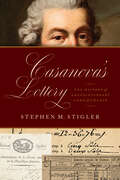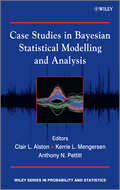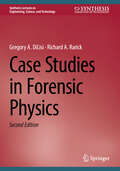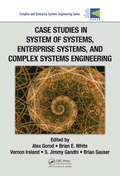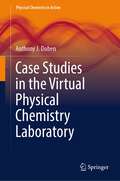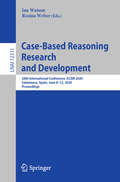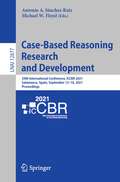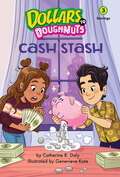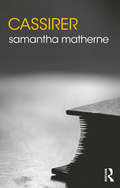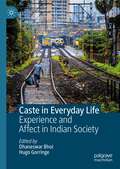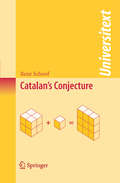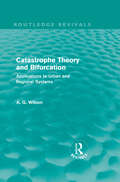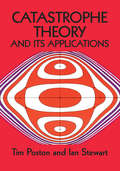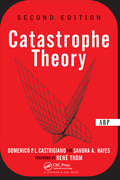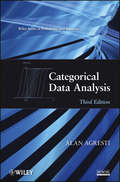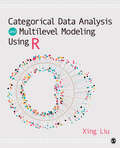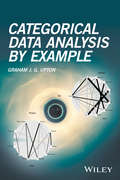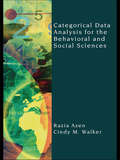- Table View
- List View
Cartoon Guide to Statistics Apple FF
by Larry Gonick Woollcott SmithIf you have ever looked for P-values by shopping at P mart, tried to watch the Bernoulli Trails on "People's Court," or think that the standard deviation is a criminal offense in six states, then you need The Cartoon Guide to Statistics to put you on the road to statistical literacy.The Cartoon Guide to Statistics covers all the central ideas of modern statistics: the summary and display of data, probability in gambling and medicine, random variables, Bernoulli Trails, the Central Limit Theorem, hypothesis testing, confidence interval estimation, and much more—all explained in simple, clear, and yes, funny illustrations. Never again will you order the Poisson Distribution in a French restaurant!This updated version features all new material.
Casanova's Lottery: The History of a Revolutionary Game of Chance
by Stephen M. StiglerThe fascinating story of an important lottery that flourished in France from 1757 to 1836 and its role in transforming our understanding of the nature of risk. In the 1750s, at the urging of famed adventurer Giacomo Casanova, the French state began to embrace risk in adopting a new Loterie. The prize amounts paid varied, depending on the number of tickets bought and the amount of the bet, as determined by each individual bettor. The state could lose money on any individual Loterie drawing while being statistically guaranteed to come out on top in the long run. In adopting this framework, the French state took on risk in a way no other has, before or after. At each drawing the state was at risk of losing a large amount; what is more, that risk was precisely calculable, generally well understood, and yet taken on by the state with little more than a mathematical theory to protect it. Stephen M. Stigler follows the Loterie from its curious inception through its hiatus during the French Revolution, its renewal and expansion in 1797, and finally to its suppression in 1836, examining throughout the wider question of how members of the public came to trust in new financial technologies and believe in their value. Drawing from an extensive collection of rare ephemera, Stigler pieces together the Loterie’s remarkable inner workings, as well as its implications for the nature of risk and the role of lotteries in social life over the period 1700–1950. Both a fun read and fodder for many fields, Casanova's Lottery shines new light on the conscious introduction of risk into the management of a nation-state and the rationality of playing unfair games.
Casanova's Lottery: The History of a Revolutionary Game of Chance
by Stephen M. StiglerThe fascinating story of an important lottery that flourished in France from 1757 to 1836 and its role in transforming our understanding of the nature of risk. In the 1750s, at the urging of famed adventurer Giacomo Casanova, the French state began to embrace risk in adopting a new Loterie. The prize amounts paid varied, depending on the number of tickets bought and the amount of the bet, as determined by each individual bettor. The state could lose money on any individual Loterie drawing while being statistically guaranteed to come out on top in the long run. In adopting this framework, the French state took on risk in a way no other has, before or after. At each drawing the state was at risk of losing a large amount; what is more, that risk was precisely calculable, generally well understood, and yet taken on by the state with little more than a mathematical theory to protect it. Stephen M. Stigler follows the Loterie from its curious inception through its hiatus during the French Revolution, its renewal and expansion in 1797, and finally to its suppression in 1836, examining throughout the wider question of how members of the public came to trust in new financial technologies and believe in their value. Drawing from an extensive collection of rare ephemera, Stigler pieces together the Loterie’s remarkable inner workings, as well as its implications for the nature of risk and the role of lotteries in social life over the period 1700–1950. Both a fun read and fodder for many fields, Casanova's Lottery shines new light on the conscious introduction of risk into the management of a nation-state and the rationality of playing unfair games.
Casanova's Lottery: The History of a Revolutionary Game of Chance
by Stephen M. StiglerThe fascinating story of an important lottery that flourished in France from 1757 to 1836 and its role in transforming our understanding of the nature of risk. In the 1750s, at the urging of famed adventurer Giacomo Casanova, the French state began to embrace risk in adopting a new Loterie. The prize amounts paid varied, depending on the number of tickets bought and the amount of the bet, as determined by each individual bettor. The state could lose money on any individual Loterie drawing while being statistically guaranteed to come out on top in the long run. In adopting this framework, the French state took on risk in a way no other has, before or after. At each drawing the state was at risk of losing a large amount; what is more, that risk was precisely calculable, generally well understood, and yet taken on by the state with little more than a mathematical theory to protect it. Stephen M. Stigler follows the Loterie from its curious inception through its hiatus during the French Revolution, its renewal and expansion in 1797, and finally to its suppression in 1836, examining throughout the wider question of how members of the public came to trust in new financial technologies and believe in their value. Drawing from an extensive collection of rare ephemera, Stigler pieces together the Loterie’s remarkable inner workings, as well as its implications for the nature of risk and the role of lotteries in social life over the period 1700–1950. Both a fun read and fodder for many fields, Casanova's Lottery shines new light on the conscious introduction of risk into the management of a nation-state and the rationality of playing unfair games.
Case Studies in Applied Bayesian Data Science: CIRM Jean-Morlet Chair, Fall 2018 (Lecture Notes in Mathematics #2259)
by Kerrie L. Mengersen Christian P. Robert Pierre PudloPresenting a range of substantive applied problems within Bayesian Statistics along with their Bayesian solutions, this book arises from a research program at CIRM in France in the second semester of 2018, which supported Kerrie Mengersen as a visiting Jean-Morlet Chair and Pierre Pudlo as the local Research Professor. The field of Bayesian statistics has exploded over the past thirty years and is now an established field of research in mathematical statistics and computer science, a key component of data science, and an underpinning methodology in many domains of science, business and social science. Moreover, while remaining naturally entwined, the three arms of Bayesian statistics, namely modelling, computation and inference, have grown into independent research fields. While the research arms of Bayesian statistics continue to grow in many directions, they are harnessed when attention turns to solving substantive applied problems. Each such problem set has its own challenges and hence draws from the suite of research a bespoke solution. The book will be useful for both theoretical and applied statisticians, as well as practitioners, to inspect these solutions in the context of the problems, in order to draw further understanding, awareness and inspiration.
Case Studies in Bayesian Methods for Biopharmaceutical CMC (Chapman & Hall/CRC Biostatistics Series)
by Tony Pourmohamad Paul FayaThe subject of this book is applied Bayesian methods for chemistry, manufacturing, and control (CMC) studies in the biopharmaceutical industry. The book has multiple authors from industry and academia, each contributing a case study (chapter). The collection of case studies covers a broad array of CMC topics, including stability analysis, analytical method development, specification setting, process development and optimization, process control, experimental design, dissolution testing, and comparability studies. The analysis of each case study includes a presentation of code and reproducible output. This book is written with an academic level aimed at practicing nonclinical biostatisticians, most of whom have graduate degrees in statistics. • First book of its kind focusing strictly on CMC Bayesian case studies • Case studies with code and output • Representation from several companies across the industry as well as academia • Authors are leading and well-known Bayesian statisticians in the CMC field • Accompanying website with code for reproducibility • Reflective of real-life industry applications/problems
Case Studies in Bayesian Statistical Modelling and Analysis
by Kerrie L. Mengersen Anthony N. Pettitt Clair L. AlstonProvides an accessible foundation to Bayesian analysis using real world modelsThis book aims to present an introduction to Bayesian modelling and computation, by considering real case studies drawn from diverse fields spanning ecology, health, genetics and finance. Each chapter comprises a description of the problem, the corresponding model, the computational method, results and inferences as well as the issues that arise in the implementation of these approaches.Case Studies in Bayesian Statistical Modelling and Analysis:Illustrates how to do Bayesian analysis in a clear and concise manner using real-world problems.Each chapter focuses on a real-world problem and describes the way in which the problem may be analysed using Bayesian methods.Features approaches that can be used in a wide area of application, such as, health, the environment, genetics, information science, medicine, biology, industry and remote sensing.Case Studies in Bayesian Statistical Modelling and Analysis is aimed at statisticians, researchers and practitioners who have some expertise in statistical modelling and analysis, and some understanding of the basics of Bayesian statistics, but little experience in its application. Graduate students of statistics and biostatistics will also find this book beneficial.
Case Studies in Forensic Physics (Synthesis Lectures on Engineering, Science, and Technology)
by Gregory A. DiLisi Richard A. RarickThis book applies basic principles of physics to conduct forensics-style re-examinations of several historical events. The authors familarize readers with introductory-level physics while demonstrating how physics concepts can be utilized to resolve historical debates about unsolved mysteries and controversial events. Each chapter introduces a new physics concept, then applies that concept to case studies in detail. The authors also identify the advantages of using case studies as a pedagogical approach to understanding physics. This second edition expands the number of physics principles and case studies covered. The book provides readers with the tools of a good forensic physicist and the ability to utilize them for real-world applications.
Case Studies in System of Systems, Enterprise Systems, and Complex Systems Engineering (Complex and Enterprise Systems Engineering)
by Alex Gorod Brian E. White Vernon Ireland S. Jimmy Gandhi Brian SauserSuitable as a reference for industry practitioners and as a textbook for classroom use, Case Studies in System of Systems, Enterprise Systems, and Complex Systems Engineering provides a clear understanding of the principles and practice of system of systems engineering (SoSE), enterprise systems engineering (ESE), and complex systems engineering (C
Case Studies in the Virtual Physical Chemistry Laboratory (Physical Chemistry in Action)
by Anthony J. DubenThis textbook provides a unique instructional resource in experimental Physical Chemistry with case studies based on data taken from the scientific literature. Platform-independent software that generates individualized data sets for student practice and assessment is included. Case Studies in the Virtual Physical Laboratory can be used to • Create online virtual laboratory courses in Physical Chemistry. • Supplement instruction in the lecture hall. • Complement hands-on projects in face-to-face laboratory courses. The case studies cover states of matter, thermochemistry, phase equilibria, reaction equilibria, chemical kinetics, electrolyte solutions, and activity coefficients. They are written to be self-contained to give flexibility in the choice of projects. The pedagogical approach in each case study is to use the given data in direct instruction followed by the analysis of the synthetic data as individualized tasks. Only open-source software tools are needed to analyze data. Each case study contains a thorough discussion of the theoretical principles underlying the experiment and data, the character of the data to be analyzed, and methods appropriate for the analysis of the data. The accompanying software has been written to allow the production of many data sets without risking duplication, yet the synthetic data can be regenerated if the files are lost or become corrupted. Software programs were written in Fortran 95 and are distributed as a suite of executable programs for Intel-based computers running Windows, MacOS, or Linux. This book will be of particular interest and usefulness to students and instructors in upper-division undergraduate physical chemistry courses.
Case-Based Reasoning Research and Development: 28th International Conference, ICCBR 2020, Salamanca, Spain, June 8–12, 2020, Proceedings (Lecture Notes in Computer Science #12311)
by Ian Watson Rosina WeberThis book constitutes the refereed proceedings of the 28th International Conference on Case-Based Reasoning Research and Development, ICCBR 2020, held in Salamanca, Spain*, in June 2020. The 20 full papers and 2 short papers presented in this book were carefully reviewed and selected from 64 submissions. The theme of ICCBR 2020, “CBR Across Bridges” was highlighted by several activities. These papers, which are included in the proceedings, address many themes related to the theory and application of case-based reasoning and its future direction. *The conference was held virtually due to the COVID-19 pandemic.
Case-Based Reasoning Research and Development: 29th International Conference, ICCBR 2021, Salamanca, Spain, September 13–16, 2021, Proceedings (Lecture Notes in Computer Science #12877)
by Antonio A. Sánchez-Ruiz Michael W. FloydThis book constitutes the proceedings of the 29th International Conference on Case-Based Reasoning, ICCBR 2021, which took place in Salamanca, Spain, during September 13-16, 2021. The 21 papers presented in this volume were carefully reviewed and selected from 85 submissions. They deal with AI and related research focusing on comparison and integration of CBR with other AI methods such as deep learning architectures, reinforcement learning, lifelong learning, and eXplainable AI (XAI).
Cash Stash: Savings (Dollars to Doughnuts #3)
by Catherine DalyFrom budgeting to spending, to piggy banks to savings accounts, this new early chapter book series tackles and explains big financial topics for kids, Dollars to Doughnuts!Julian has saved his pennies—and quarters and dollars—for ages. He keeps them in a safe place, at the top of the closet, behind his winter blanket in his trusty piggy bank, Wilbur. But now his mom, his dad, even his best friend, Lucy, who barely saves any money at all, says Wilbur isn&’t safe enough. They want him to move his money to a bank! Will Julian keep Wilbur, or open a savings account? What&’s the right thing to do?
Cassirer (The Routledge Philosophers)
by Samantha MatherneErnst Cassirer (1874–1945) occupies a unique place in 20th-century philosophy. His view that human beings are not rational but symbolic animals and his famous dispute with Martin Heidegger at Davos in 1929 are compelling alternatives to the deadlock between 'analytic' and 'continental' approaches to philosophy. An astonishing polymath, Cassirer's work pays equal attention to mathematics and natural science but also art, language, myth, religion, technology, and history. However, until now the importance of his work has largely been overlooked. In this outstanding introduction Samantha Matherne examines and assesses the full span of Cassirer’s work. Beginning with an overview of his life and works she covers the following important topics: Cassirer’s neo-Kantian background Philosophy of mathematics and natural science, including Cassirer’s first systematic work, Substance and Function, and subsequent works, like Einstein’s Theory of Relativity The problem of culture and the ground-breaking The Philosophy of Symbolic Forms Cassirer’s ethical and political thought and his diagnosis of fascism in The Myth of the State Cassirer’s influence and legacy. Including chapter summaries, suggestions for further reading, and a glossary of terms, this is an ideal introduction to Cassirer’s thought for anyone coming to his work for the first time. It is essential reading for students in philosophy as well as related disciplines such as intellectual history, art history, politics, and literature.
Caste in Everyday Life: Experience and Affect in Indian Society
by Hugo Gorringe Dhaneswar BhoiThis edited volume brings together a range of scholars to reflect on the varied ways in which caste is manifested and experienced in social life. Each chapter draws on different methods and approaches but all consider lived experiences and experiential narrations. Considering Guru and Sarukkai’s path-breaking work on ‘Experience, Caste and the Everyday Social’ (2019), this volume applies the insights of the theories to multiple settings, issues and communities. Unique to this volume, Brahmin and other dominant castes' experiences are considered, rather than simply focusing on the lives of oppressed castes (Dalits). Analysis of cross-caste friendships or romances and marriages, furthermore, brings out the intimate and ingrained aspects of caste. Taken together, therefore, the contributions in this volume offer rich insights into caste and its consciousness within the framework of everyday experiences.
Catalan Numbers
by Richard P. StanleyCatalan numbers are probably the most ubiquitous sequence of numbers in mathematics. This book provides, for the first time, a comprehensive collection of their properties and applications in combinatorics, algebra, analysis, number theory, probability theory, geometry, topology, and other areas. After an introduction to the basic properties of Catalan numbers, the book presents 214 different kinds of objects which are counted using Catalan numbers, including of exercises with solutions. The reader can try solving the exercises or simply browse through them. 68 additional exercises with prescribed difficulty levels present various properties of Catalan numbers and related numbers, such as Fuss-Catalan numbers, Motzkin numbers, Schröder numbers, Narayana numbers, super Catalan numbers, q-Catalan numbers and (q,t)-Catalan numbers. The book concludes with a history of Catalan numbers by Igor Pak and a glossary of key terms. Whether your interest in mathematics is recreation or research, you will find plenty of fascinating and stimulating facts here.
Catalan's Conjecture (Universitext)
by René SchoofEugène Charles Catalan made his famous conjecture - that 8 and 9 are the only two consecutive perfect powers of natural numbers - in 1844 in a letter to the editor of Crelle's mathematical journal. One hundred and fifty-eight years later, Preda Mihailescu proved it. Catalan's Conjecture presents this spectacular result in a way that is accessible to the advanced undergraduate. The author dissects both Mihailescu's proof and the earlier work it made use of, taking great care to select streamlined and transparent versions of the arguments and to keep the text self-contained. Only in the proof of Thaine's theorem is a little class field theory used; it is hoped that this application will motivate the interested reader to study the theory further. Beautifully clear and concise, this book will appeal not only to specialists in number theory but to anyone interested in seeing the application of the ideas of algebraic number theory to a famous mathematical problem.
Catastrophe Theory and Bifurcation: Applications to Urban and Regional Systems (Routledge Revivals)
by Alan WilsonMathematical models have long been used by geographers and regional scientists to explore the working of urban and regional systems, via a system where the equilibrium point changes slowly and smoothly as the parameters change slowly and smoothly. However, this all changed with the advent of catastrophe theory and bifurcation, which enabled the development of models where a quite sudden change in the position of the equilibrium point results from a slow, small, smooth change in one or more parameters. First published in 1981, this reissue of Professor Wilson’s classic study outlines the implications of these mathematical models for geography and regional science, by way of a survey of contemporary applications.
Catastrophe Theory and Its Applications
by Ian Stewart Tim PostonFirst integrated treatment of main ideas behind René Thom's theory of catastrophes stresses detailed applications in the physical sciences. Mathematics of theory explained with a minimum of technicalities. Over 200 illustrations clarify text designed for researchers and postgraduate students in engineering, mathematics, physics and biology. 1978 edition. Bibliography.
Catastrophe Theory: Second Edition
by Domencio CastrigianoCatastrophe Theory was introduced in the 1960s by the renowned Fields Medal mathematician René Thom as a part of the general theory of local singularities. Since then it has found applications across many areas, including biology, economics, and chemical kinetics. By investigating the phenomena of bifurcation and chaos, Catastrophe Theory proved to
Categorical Data Analysis
by Alan AgrestiPraise for the Second Edition"A must-have book for anyone expecting to do research and/or applications in categorical data analysis."--Statistics in Medicine"It is a total delight reading this book."--Pharmaceutical Research"If you do any analysis of categorical data, this is an essential desktop reference."--TechnometricsThe use of statistical methods for analyzing categorical data has increased dramatically, particularly in the biomedical, social sciences, and financial industries. Responding to new developments, this book offers a comprehensive treatment of the most important methods for categorical data analysis.Categorical Data Analysis, Third Edition summarizes the latest methods for univariate and correlated multivariate categorical responses. Readers will find a unified generalized linear models approach that connects logistic regression and Poisson and negative binomial loglinear models for discrete data with normal regression for continuous data. This edition also features:An emphasis on logistic and probit regression methods for binary, ordinal, and nominal responses for independent observations and for clustered data with marginal models and random effects modelsTwo new chapters on alternative methods for binary response data, including smoothing and regularization methods, classification methods such as linear discriminant analysis and classification trees, and cluster analysisNew sections introducing the Bayesian approach for methods in that chapterMore than 100 analyses of data sets and over 600 exercisesNotes at the end of each chapter that provide references to recent research and topics not covered in the text, linked to a bibliography of more than 1,200 sourcesA supplementary website showing how to use R and SAS; for all examples in the text, with information also about SPSS and Stata and with exercise solutionsCategorical Data Analysis, Third Edition is an invaluable tool for statisticians and methodologists, such as biostatisticians and researchers in the social and behavioral sciences, medicine and public health, marketing, education, finance, biological and agricultural sciences, and industrial quality control.
Categorical Data Analysis and Multilevel Modeling Using R
by Xing LiuCategorical Data Analysis and Multilevel Modeling Using R provides a practical guide to regression techniques for analyzing binary, ordinal, nominal, and count response variables using the R software. Author Xing Liu offers a unified framework for both single-level and multilevel modeling of categorical and count response variables with both frequentist and Bayesian approaches. Each chapter demonstrates how to conduct the analysis using R, how to interpret the models, and how to present the results for publication. A companion website for this book contains datasets and R commands used in the book for students, and solutions for the end-of-chapter exercises on the instructor site.
Categorical Data Analysis and Multilevel Modeling Using R
by Xing LiuCategorical Data Analysis and Multilevel Modeling Using R provides a practical guide to regression techniques for analyzing binary, ordinal, nominal, and count response variables using the R software. Author Xing Liu offers a unified framework for both single-level and multilevel modeling of categorical and count response variables with both frequentist and Bayesian approaches. Each chapter demonstrates how to conduct the analysis using R, how to interpret the models, and how to present the results for publication. A companion website for this book contains datasets and R commands used in the book for students, and solutions for the end-of-chapter exercises on the instructor site.
Categorical Data Analysis by Example
by UptonIntroduces the key concepts in the analysis of categoricaldata with illustrative examples and accompanying R code This book is aimed at all those who wish to discover how to analyze categorical data without getting immersed in complicated mathematics and without needing to wade through a large amount of prose. It is aimed at researchers with their own data ready to be analyzed and at students who would like an approachable alternative view of the subject. Each new topic in categorical data analysis is illustrated with an example that readers can apply to their own sets of data. In many cases, R code is given and excerpts from the resulting output are presented. In the context of log-linear models for cross-tabulations, two specialties of the house have been included: the use of cobweb diagrams to get visual information concerning significant interactions, and a procedure for detecting outlier category combinations. The R code used for these is available and may be freely adapted. In addition, this book: * Uses an example to illustrate each new topic in categorical data * Provides a clear explanation of an important subject * Is understandable to most readers with minimal statistical and mathematical backgrounds * Contains examples that are accompanied by R code and resulting output * Includes starred sections that provide more background details for interested readers Categorical Data Analysis by Example is a reference for students in statistics and researchers in other disciplines, especially the social sciences, who use categorical data. This book is also a reference for practitioners in market research, medicine, and other fields. GRAHAM J. G. UPTON is formerly Professor of Applied Statistics, Department of Mathematical Sciences, University of Essex. Dr. Upton is author of The Analysis of Cross-tabulated Data (1978) and joint author of Spatial Data Analysis by Example (2 volumes, 1995), both published by Wiley. He is the lead author of The Oxford Dictionary of Statistics (OUP, 2014). His books have been translated into Japanese, Russian, and Welsh.
Categorical Data Analysis for the Behavioral and Social Sciences
by Razia Azen Cindy M. WalkerFeaturing a practical approach with numerous examples, this book focuses on helping the reader develop a conceptual, rather than technical, understanding of categorical methods, making it a much more accessible text than others on the market. The authors cover common categorical analyses and emphasize specific research questions that can be addressed by each analytic procedure so that readers are able to address the research questions they wish to answer. To achieve this goal, the authors: Review the theoretical implications and assumptions underlying each of the procedures Present each concept in general terms and illustrate each with a practical example Demonstrate the analyses using SPSS and SAS and show the interpretation of the results provided by these programs. A "Look Ahead" section at the beginning of each chapter provides an overview of the material covered so that the reader knows what to expect. This is followed by one or more research questions that can be addressed using the procedure(s) covered in the chapter. A theoretical presentation of the material is provided and illustrated using realistic examples from the behavioral and social sciences. To further enhance accessibility, the new procedures introduced in the book are explicitly related to analytic procedures covered in earlier statistics courses, such as ANOVA and linear regression. Throughout each chapter the authors use practical examples to demonstrate how to obtain and interpret statistical output in both SPSS and SAS. Their emphasis on the relationship between the initial research question, the use of the software to carry out the analysis, and the interpretation of the output as it relates to the initial research question, allows readers to easily apply the material to their own research. The data sets for executing chapter examples using SAS Version 9.1.3 and/or IBM SPSS Version 18 are available on a book specific web site. These data sets and syntax allow readers to quickly run the programs and obtain the appropriate output. The book also includes both conceptual and analytic end-of-chapter exercises to assist instructors and students in evaluating the understanding of the material covered in each chapter. This book covers the most commonly used categorical data analysis procedures. It is written for those without an extensive mathematical background, and is ideal for graduate courses in categorical data analysis or cross-classified data analysis taught in departments of psychology, human development & family studies, sociology, education, and business. Researchers in these disciplines interested in applying these procedures to their own research will appreciate this book’s accessible approach.
